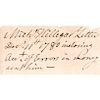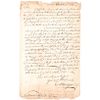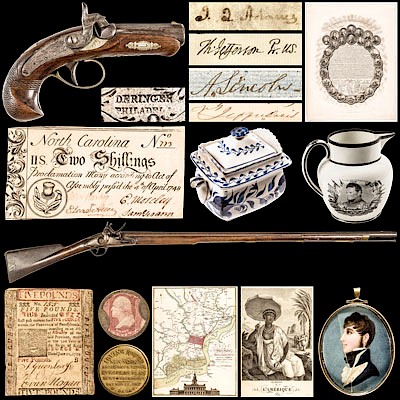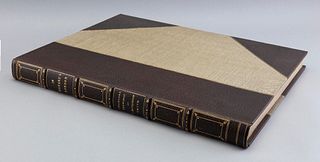1780 MICHAEL HILLEGAS Signed Letter as First U.S. Continental Congress Treasurer
Lot 47
Categories
Estimate:
$2,500 - $3,000
Absentee vs Live bid
Two ways to bid:
- Leave a max absentee bid and the platform will bid on your behalf up to your maximum bid during the live auction.
- Bid live during the auction and your bids will be submitted real-time to the auctioneer.
Bid Increments
| Price | Bid Increment |
|---|---|
| $0 | $10 |
| $200 | $20 |
| $300 | $25 |
| $500 | $50 |
| $1,000 | $100 |
| $2,000 | $200 |
| $3,000 | $250 |
| $5,000 | $500 |
| $10,000 | $1,000 |
| $20,000 | $2,000 |
| $30,000 | $2,500 |
| $50,000 | $5,000 |
| $100,000 | $10,000 |
| $200,000 | $20,000 |
| $300,000 | $25,000 |
| $500,000 | $50,000 |
About Auction
By Early American History Auctions
Oct 19, 2019
Set Reminder
2019-10-19 12:00:00
2019-10-19 12:00:00
America/New_York
Bidsquare
Bidsquare : Historic Autographs-Currency-Political-Americana-Militaria-Guns
https://www.bidsquare.com/auctions/early-american-history-auctions/historic-autographs-currency-political-americana-militaria-guns-4513
326 Lots of Rare, Historic Autographs, Americana, Civil War Era, George Washington, Abraham Lincoln, Black History, Revolutionary War Era, Colonial America, Federal Period, War of 1812, Colonial Currency, Indian Peace Medals & more... Early American History Auctions auctions@earlyamerican.com
326 Lots of Rare, Historic Autographs, Americana, Civil War Era, George Washington, Abraham Lincoln, Black History, Revolutionary War Era, Colonial America, Federal Period, War of 1812, Colonial Currency, Indian Peace Medals & more... Early American History Auctions auctions@earlyamerican.com
- Lot Description
Autographs
Michael Hillegas Writes Regarding Revolutionary War Period Counterfeit Massachusetts Currency of May 5, 1780
MICHAEL HILLEGAS (1729-1804), First Treasurer of the United States for the Continental Congress, Hillegas edited the Declaration of Independence, used much of his own personal funds to help support the American Revolutionary War, and his portrait appears on the Ten-dollar Gold Certificate in the currency series issued in the years 1907 and 1922.
December 11, 1780-Dated Revolutionary War Period, Historical Content Autograph Letter Signed, "Ml. Hillegas Contl. Treas." (Continental Congress Treasurer), 1 page, folio, Philadelphia, as the First Treasurer of the United States, Very Fine. Hillegas was in office from July 29, 1775 to September 11, 1789. Here, Hillegas writes to Nathaniel Appleton, the Commissioner of the Continental Loan Office in Massachusetts, enclosing:
"the Account of Errors discovered in the 1,7500,000 Dollars sent me... some time since, the Balance on which is nine thousand eight hundred & eighty Dollars against you. I doubt not you'll be satisfied wth. the justness of the Account, particularly as I inclose you the Lists on the Bundles as well as the Counterfeits of the same. I made out a Copy of your letter complaining of the Hardship you apprehended you laboured under was you to be obliged to account for the Counterfeits, which Copy I laid before the Hon'ble the Board of Treasury, in order That they might lay it before Congress for this determination, But I have not as yet heard anything..."
Wear at edges, clean split at horizontal fold. Otherwise a bold and clear letter. Presumably the counterfeits were among the local currency that was to be exchanged for new notes according to a resolution of the Continental Congress made in March 1780. Appleton was apparently not held responsible for them, for he continued his long career as one of Massachusetts' leading financial officials.
Michael Hillegas was born in Philadelphia, Pennsylvania, the son of an immigrant from Germany and a well-to-do merchant involved in iron and sugar. Soon Michael thus had the freedom and resources to participate in local politics. He married Henrietta Boude on May 10, 1753, at Christ Church in Philadelphia, and they went on to have many children.
Hillegas was a member of the Pennsylvania Provincial Assembly from 1765 to 1775 and served as treasurer of the Committee of Safety (American Revolution) under Benjamin Franklin in 1774.
On July 29, 1775, Hillegas and fellow patriot George Clymer were appointed by the Continental Congress to share the office of Treasurer of the United Colonies. Because Hillegas edited the Declaration of Independence, when the Declaration of Independence was signed, Clymer's signature appeared on the document.
After Clymer's resignation on August 6, 1776, Hillegas assumed sole ownership of the office, which he held throughout the remainder of the American Revolution, using much of his own fortune to support the cause. His son, Samuel Hillegas, was also given the authority to sign new currency, known as "Continentals." Hillegas also served briefly as quartermaster to the army and served on occasional commissions.
On September 9, 1776, the Continental Congress officially changed the name of the country to the United States of America, but Hillegas's title did not officially change until March 1778. On September 11, 1789, Congress created the Treasury Department, and Alexander Hamilton took the oath of office as the first Secretary of the Treasury. On that same date, Hillegas tendered his resignation, and Samuel Meredith was appointed Treasurer.
Hillegas was also an early member of the American Philosophical Society, along with Franklin. He died in Philadelphia and is buried near Franklin in Christ Church Burial Ground. Late in the 19th century, his descendants petitioned to have his portrait appear on the ten-dollar gold certificate in the series issued in the years 1907 and 1922
- Shipping Info
-
Early American provides in-house worldwide shipping. Please contact us directly if you have questions about your specific shipping requirements.
-
- Buyer's Premium



 EUR
EUR CAD
CAD AUD
AUD GBP
GBP MXN
MXN HKD
HKD CNY
CNY MYR
MYR SEK
SEK SGD
SGD CHF
CHF THB
THB













